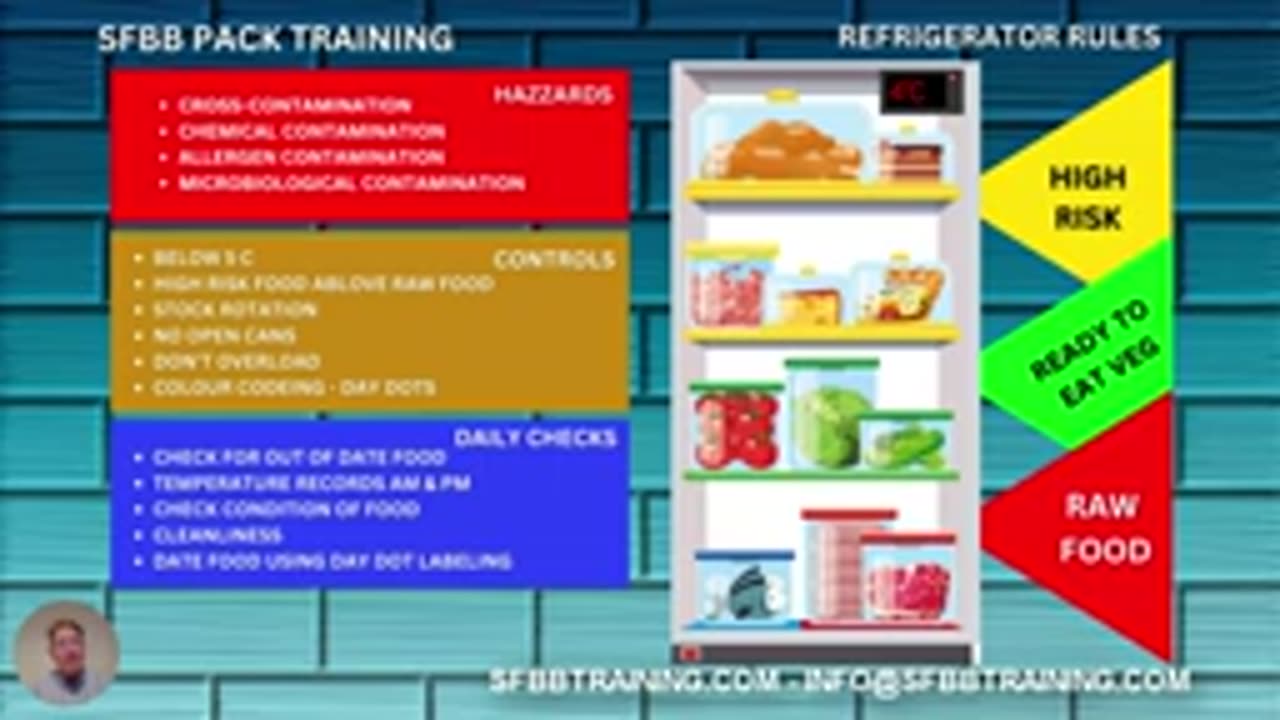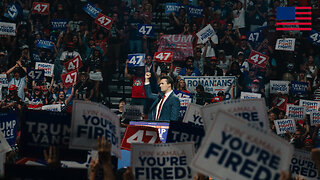Premium Only Content

SFBB Pack Training Fridge Rules Temperature Checks, Hazards _ Controls
**SFBB Pack Training** on **Fridge Rules, Temperature Checks, Hazards, and Controls** focuses on the importance of proper refrigeration to ensure food safety. Here's a detailed breakdown tailored for training staff or ESL learners:
---
### **1. Fridge Rules in the SFBB Pack**
Proper fridge management is essential for keeping food safe. Here are the basic rules:
- **Store food at the right temperature:**
- **Fridges should be kept at or below 5°C** (41°F).
- **Freezers should be at or below -18°C** (0°F).
- **Keep raw and ready-to-eat foods separate:**
- Raw meat should be stored at the bottom of the fridge in sealed containers to prevent its juices from dripping onto other food.
- **Cover food properly:**
- Use tight-sealing containers or plastic wrap to protect food from contamination and drying out.
- **Don’t overload the fridge:**
- Allow space for air to circulate freely and keep the temperature consistent.
- **Store food in order:**
- Place **cooked food on higher shelves** and **raw food on lower shelves**.
---
### **2. Temperature Checks**
Regular temperature checks are vital to ensure that the fridge is operating correctly. Here's how to do it properly:
#### a. **When to Check Temperatures**
- **Daily:** Check the fridge temperature every day at the same time.
- **After loading the fridge:** Whenever food is added, ensure the fridge is still operating at the correct temperature.
- **If the door is left open for too long:** Check the temperature if the fridge has been opened frequently or for extended periods.
#### b. **How to Check**
- Use a **thermometer** to check the fridge and freezer temperatures.
- Insert the thermometer in a representative location inside the fridge (not in the door).
- Record the temperature on your **SFBB Daily Diary**.
#### c. **Temperature Guidelines**
- **Fridge temperature:** **5°C or below**.
- **Freezer temperature:** **-18°C or below**.
- **Hot food storage:** Keep hot food at **63°C** or above.
#### d. **What to Do if the Temperature Is Wrong**
- If the fridge is above 5°C, **cool food quickly** by placing it in a smaller, shallow container, and **refrigerate it** again immediately.
- If the fridge cannot maintain a safe temperature, **move food to a different fridge** or freezer, and **contact a repair technician**.
---
### **3. Hazards of Improper Fridge Use**
Improper fridge management can lead to the following hazards:
#### a. **Bacterial Growth**
- Bacteria thrive in the **danger zone** between **5°C and 63°C**.
- If food is stored above 5°C for too long, harmful bacteria like **Salmonella** or **E. coli** can grow.
#### b. **Cross-Contamination**
- Storing raw meat improperly can lead to **juices leaking** onto ready-to-eat food, causing cross-contamination and foodborne illness.
#### c. **Spoilage**
- Food stored at the wrong temperature or for too long may **spoil** or **lose freshness**, making it unsafe or unappealing to eat.
---
### **4. Control Measures for Safe Fridge Use**
To control these hazards and ensure food safety, follow these measures:
#### a. **Temperature Control**
- Regularly check fridge and freezer temperatures.
- Ensure that temperatures are **recorded in your SFBB Daily Diary**.
#### b. **Separation of Raw and Ready-to-Eat Foods**
- **Use separate storage containers** for raw and ready-to-eat foods.
- **Store raw meat at the bottom of the fridge** to prevent juices from dripping onto other foods.
#### c. **Monitor and Maintain Fridge Condition**
- Ensure that **fridge doors seal tightly** to maintain a stable internal temperature.
- Keep **fridges clean** to avoid mold, bacteria, and unpleasant odors.
- **Defrost the freezer regularly** to ensure it works efficiently.
#### d. **Keep Fridge Well-Organized**
- **Label and date** food in the fridge to track when it was stored.
- **Follow FIFO (First In, First Out)** – use older stock before newer stock.
#### e. **Emergency Procedures**
- If the fridge or freezer breaks down:
- **Move perishable food** to another fridge or freezer.
- Keep food **below 5°C** or **above 63°C**.
- **Dispose of any food** that has been outside the safe temperature range for more than 2 hours.
---
### **5. Training Tips for ESL Learners**
To ensure that all staff understand and can implement these rules, here are some training tips:
- **Use visual aids:** Diagrams of fridge layouts, temperature charts, and examples of properly stored food.
- **Simplify language:** Explain in clear and simple terms, using everyday language.
- Example: "Raw chicken must be at the bottom of the fridge so its juice doesn’t drip onto other food."
- **Practice hands-on activities:** Let learners practice checking fridge temperatures and organizing food storage.
- **Quiz and repeat:** Ask questions to reinforce learning and check understanding.
---
### **6. Monitoring and Documentation**
- **Daily Diary:** Staff should record fridge temperatures in the **SFBB Daily Diary** to ensure that temperatures are within the safe range.
- **Routine Inspections:** Conduct regular fridge checks to monitor food storage conditions and food safety compliance.
---
### **Common Questions for Staff or ESL Learners:**
- **Where should you store raw meat in the fridge?**
- Answer: "At the bottom in sealed containers."
- **What should you do if the fridge temperature is over 5°C?**
- Answer: "Check the food, move it to another fridge if needed, and report the issue."
---
### **Final Review**
- Regular temperature checks and fridge management are essential for maintaining food safety.
- Safe food storage involves **keeping the right temperature**, **separating raw and ready-to-eat foods**, and **using the correct containers**.
Would you like a printable checklist for fridge management or a template for temperature recording?
-
 33:14
33:14
Tudor Dixon
2 hours agoThe World Walk with Tom Turcich | The Tudor Dixon Podcast
10.5K -
 7:29:48
7:29:48
PudgeTV
8 hours ago🔴 Gaming on Rumble - Marvel Rivals | Iron Man's Armory: Equipping Groot and Jeff for Battle
19.3K2 -
 1:58:48
1:58:48
The Charlie Kirk Show
2 hours ago2024 In Review + The Truth About H-1Bs | Girdusky, Carl | 12.30.24
61.3K17 -
 6:51
6:51
The Rubin Report
3 hours agoDave Rubin Reacts to Trump’s Greatest Moments
29.5K4 -
 DVR
DVR
Bannons War Room
1 year agoWarRoom Live
102M -
 0:57
0:57
Steven Crowder
4 hours agoCROWDER CLASSICS: AOC & the Lion’s Den (Bible Story Parody)
89.6K8 -
 50:00
50:00
Graham Allen
6 hours agoGoodbye 2024…. HELLO 2025!!
72.3K17 -
 2:01:16
2:01:16
LFA TV
17 hours agoH1B FIASCO! | LIVE FROM AMERICA 12.30.24 11am EST
41.3K26 -
 2:05:37
2:05:37
Matt Kohrs
17 hours agoStocks Puke, Breaking News & BIG Updates || The MK Show
61K3 -
 51:57
51:57
Dad Dojo Podcast
5 hours ago $2.37 earnedEP15: The Bronny James Debate 2
27.1K